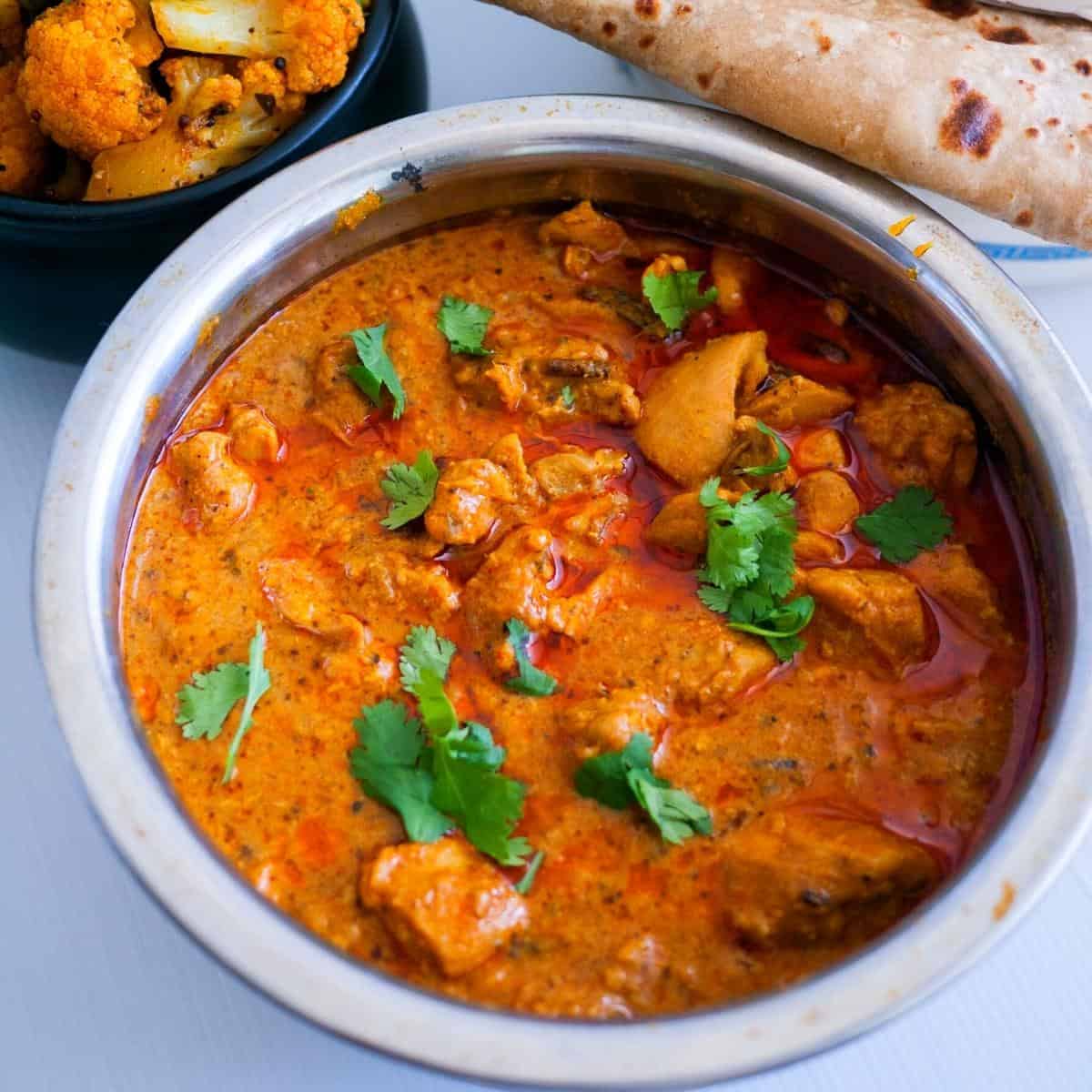Embark on a culinary journey exploring the vibrant world of egg-free curries! This isn’t about compromise; it’s about unlocking a universe of rich, complex flavors without relying on eggs. From the fragrant spice blends of South India to the zesty tang of Thai curries and the warm earthiness of North African creations, we’ll uncover diverse recipes that tantalize the taste buds and delight the senses. Discover clever ingredient substitutions that maintain texture and binding, ensuring each curry is as satisfying as it is delicious.
Prepare to delve into detailed step-by-step guides, master flavor enhancement techniques, and learn the art of visually stunning presentation. We’ll uncover the secrets to crafting aromatic curry pastes from scratch and explore ideal accompaniments that elevate your culinary experience. Get ready to create curries that are not only egg-free but bursting with an unforgettable symphony of flavors.
Egg-Free Curry Variations

Egg-free curries offer a vibrant world of flavor and texture, catering to diverse dietary needs without compromising on the richness and complexity that define this beloved dish. These recipes showcase the versatility of spices and vegetables, creating a symphony of taste in each bite.
Five Distinct Egg-Free Curry Recipes
The following five recipes demonstrate the breadth of egg-free curry possibilities, ranging from the comforting familiarity of South Indian flavors to the zesty tang of Thai and the warm earthiness of North African spices. Each recipe offers a unique culinary journey.
1. South Indian Coconut Curry with Chickpeas (Chana Masala): This hearty curry features tender chickpeas simmered in a creamy coconut milk-based sauce, infused with aromatic spices like turmeric, cumin, coriander, and chili powder. The coconut milk lends a rich, velvety texture, while the spices provide a warm, earthy depth. Imagine the vibrant orange hue of the turmeric mingling with the creamy white of the coconut milk, punctuated by the deep brown of the chickpeas. The aroma alone is enough to transport you to a bustling South Indian market.
2. Thai Green Curry with Tofu and Vegetables: A vibrant and fragrant curry, this recipe features silken tofu and an assortment of colorful vegetables like bell peppers, bamboo shoots, and zucchini, all swimming in a fragrant green curry paste. The paste, a vibrant emerald green, is a complex blend of lemongrass, galangal, chilies, and kaffir lime leaves, creating a distinctly Thai flavor profile. The curry is light yet satisfying, a perfect balance of sweet, sour, and spicy notes.
3. North African Tagine with Lamb and Apricots: This warming and aromatic tagine showcases tender lamb slow-cooked with sweet apricots, warming spices like cinnamon, ginger, and cumin, and fragrant saffron. The lamb, falling apart tender, is infused with the deep, earthy flavors of the spices and the sweetness of the apricots. Imagine the rich, reddish-brown of the lamb nestled amongst the golden apricots, the whole dish emitting a heady aroma of warm spices and sweet fruit.
4. Malaysian Chicken Rendang (Egg-Free): A rich and intensely flavorful curry, this rendition omits the traditional egg, relying instead on a blend of aromatic spices like lemongrass, galangal, turmeric, chilies, and candlenuts to create its signature depth. The chicken, braised in coconut milk until tender and infused with the spices, develops a rich, almost caramelized texture. The deep reddish-brown of the curry, punctuated by the golden-brown of the chicken, is a feast for the eyes as much as the palate.
5. Moroccan Vegetable Tagine with Chickpeas and Preserved Lemons: This vibrant and flavorful tagine features a medley of colorful vegetables like carrots, zucchini, and bell peppers, simmered with chickpeas and the unique tang of preserved lemons. The spices, including cumin, coriander, turmeric, and ginger, create a warm and inviting aroma. The bright yellow of the turmeric against the deep green of the preserved lemons and the vibrant orange of the carrots creates a stunning visual contrast.
Comparison of Egg-Free Curry Recipes
This table highlights the key ingredients and cooking methods for each of the five recipes.
| Ingredient | Method | Region | Flavor Profile |
|---|---|---|---|
| Chickpeas, Coconut Milk, Turmeric, Cumin, Coriander | Simmering | South India | Warm, Earthy, Creamy |
| Tofu, Vegetables, Green Curry Paste | Stir-frying, Simmering | Thailand | Sweet, Sour, Spicy |
| Lamb, Apricots, Cinnamon, Ginger, Cumin, Saffron | Slow Cooking | North Africa | Warm, Savory, Sweet |
| Chicken, Coconut Milk, Lemongrass, Galangal, Turmeric, Chilies, Candlenuts | Braising | Malaysia | Rich, Intense, Savory |
| Vegetables, Chickpeas, Preserved Lemons, Cumin, Coriander, Turmeric, Ginger | Simmering | Morocco | Bright, Tangy, Savory |
Spice Profiles and Their Impact on Flavor
The unique spice blends in each curry are instrumental in shaping its distinct character. In the South Indian Chana Masala, turmeric provides its signature warm, earthy note, while cumin and coriander add depth and complexity. The Thai Green Curry relies on the vibrant green curry paste, where lemongrass and galangal provide a citrusy, slightly pungent aroma, balanced by the heat of chilies and the subtle floral notes of kaffir lime leaves. The North African Tagine uses cinnamon and ginger to add warmth and sweetness, while cumin and saffron contribute depth and complexity. The Malaysian Rendang showcases the unique flavor of candlenuts, adding a nutty, slightly bitter note to the rich blend of lemongrass, galangal, and chilies. Finally, the Moroccan Tagine relies on the interplay of cumin, coriander, turmeric, and ginger to create a warm, inviting, and slightly tangy flavor profile, complemented by the unique citrus notes of the preserved lemons. Each spice contributes a specific layer of flavor, resulting in a harmonious and unforgettable culinary experience.
Flavor Enhancement Techniques for Egg-Free Curries
Elevating the taste of egg-free curries involves a masterful orchestration of aromatic spices, vibrant fresh herbs, and thoughtfully constructed spice blends. The right combination can transform a simple vegetable curry into a complex and deeply satisfying culinary experience. Understanding the nuances of flavor profiles and how they interact is key to unlocking truly exceptional egg-free curry creations.
The foundation of any flavorful curry lies in the skillful use of spices. Their warm, pungent, and sometimes subtly sweet notes intertwine to create a tapestry of taste. Fresh herbs, added at the end of cooking, contribute a bright, herbaceous counterpoint to the richness of the spices, adding layers of complexity and freshness. Homemade spice blends offer unparalleled control over the flavor profile, allowing for precise customization to suit individual preferences and the specific ingredients used in the curry.
Spice Combinations for Diverse Curries
A carefully chosen spice blend can dramatically enhance the flavor of a curry, complementing the inherent tastes of the vegetables or proteins. For example, a vibrant vegetable curry featuring butternut squash, cauliflower, and chickpeas might benefit from a blend of warming spices like cinnamon, cardamom, and ginger, balanced by the earthy notes of turmeric and cumin. The sweetness of the squash would be beautifully enhanced, while the spices would add depth and complexity without overpowering the vegetables’ natural flavors. Imagine the rich, golden hue of the curry, punctuated by the warm brown specks of the spices, the aroma filling the kitchen with a comforting warmth.
Conversely, a curry featuring lean protein like chicken or firm tofu could be elevated with a more robust spice blend. Consider a combination of fiery chili powder, fragrant coriander, assertive cumin, and smoky paprika. The heat of the chili powder would create a satisfying kick, while the other spices would add layers of complexity and depth. The visual appeal would be equally striking: tender chicken pieces or firm tofu cubes, coated in a rich, reddish-brown sauce, speckled with the vibrant colors of the spices. The aroma would be intensely savory, hinting at the exciting flavors within.
Creating a Flavorful Curry Paste from Scratch
Crafting a curry paste from scratch unlocks a world of flavor possibilities. The process is rewarding, allowing for precise control over the intensity and character of the final dish. The vibrant colors and fragrant aromas released during the preparation are a testament to the deliciousness to come.
A basic curry paste typically begins with a foundation of aromatics: ginger, garlic, and green chilies. These are finely ground or pounded into a paste, releasing their pungent oils. Then, a selection of spices is added, depending on the desired flavor profile. This could include turmeric for color and earthiness, cumin for warmth and depth, coriander for a citrusy note, and garam masala for a complex blend of flavors. The paste is then typically sautéed briefly in oil to further release its aromas and deepen its flavor. Imagine the vibrant, almost electric green of the chilies contrasting with the golden yellow of the turmeric, the whole paste exuding a fragrant, intensely spicy aroma.
A well-made curry paste is the heart and soul of a truly flavorful curry. It’s the foundation upon which all other flavors are built.
Serving Suggestions and Presentation
The final touch to any delicious egg-free curry is its presentation and the thoughtful selection of accompaniments. A visually appealing plate elevates the dining experience, enhancing the enjoyment of the vibrant flavors. Careful consideration of textures and colors creates a truly memorable meal.
Serving egg-free curries involves more than just spooning the curry onto a plate. It’s about creating a harmonious blend of tastes and textures, a symphony for the senses. The right accompaniments not only complement the curry but also provide a delightful contrast, preventing the dish from becoming monotonous.
Accompaniments for Egg-Free Curries
Choosing the right accompaniments is crucial for a balanced and satisfying meal. The texture and flavor profile of the accompaniment should complement the curry, offering a counterpoint to its richness and spice.
- Fluffy Basmati rice: Its delicate grains provide a soft contrast to the robust curry, acting as a perfect vessel for soaking up the flavorful sauce.
- Soft and pillowy Naan bread: The slightly charred exterior and airy interior of naan offer a delightful textural contrast, perfect for scooping up generous portions of curry.
- Chewy Roti: This unleavened flatbread, slightly tougher than naan, adds a hearty element to the meal, its subtle flavor allowing the curry’s spices to shine.
- Fragrant Jeera Rice: The addition of cumin seeds to the rice adds a warm, earthy note that beautifully complements many curry varieties.
- Lentil-based dishes like Dal: The creamy texture of dal offers a soothing counterpoint to the spicier curries, creating a balanced and nutritious meal.
Visually Appealing Plating Suggestions
Plating a curry is an art form. Consider the colors and textures to create a visually stunning and appetizing presentation.
- Color Contrast: A vibrant green cilantro garnish against a rich brown curry creates a striking visual effect. Similarly, a sprinkle of bright red chili flakes adds a pop of color and a hint of extra spice.
- Textural Contrast: Serving the curry alongside crunchy papadums or a sprinkle of toasted nuts adds a pleasing textural contrast to the smooth curry. The crispness of the papadum provides a welcome counterpoint to the soft texture of the rice or bread.
- Layered Presentation: A visually appealing presentation can be achieved by layering the elements of the meal. Imagine a bed of fluffy rice, topped with a generous spoonful of curry, then garnished with fresh cilantro and a few slivers of toasted almonds. The layering adds depth and visual interest.
- Use of Serving Dishes: A shallow, wide bowl allows the vibrant colors of the curry to be showcased, while a small bowl for the accompaniments adds to the overall presentation. Consider using dishes that complement the style of the curry; for example, a rustic bowl for a hearty vegetable curry, or an elegant plate for a more refined dish.
Storing Leftover Egg-Free Curries
Proper storage is key to maintaining the flavor and freshness of leftover curries.
Allow the curry to cool completely before storing it in an airtight container. This prevents the growth of harmful bacteria and helps maintain the curry’s quality. Store the curry in the refrigerator for up to three days. For longer storage, freezing is recommended. Freeze the curry in individual portions for easy reheating. When reheating, avoid microwaving, as this can sometimes alter the texture and flavor of the curry. Instead, gently reheat on the stovetop or in a saucepan, adding a little water or cream if needed to restore its consistency.
From mastering ingredient substitutions to perfecting the art of spice blending, this exploration of egg-free curries reveals a world of culinary possibilities. We’ve journeyed through diverse regional flavors, discovering the unique character of each spice and the satisfying textures achievable without eggs. With the knowledge gained here, you’re equipped to create stunning, flavorful curries that will impress even the most discerning palates. So, gather your ingredients, embrace the vibrant spices, and embark on your own delicious egg-free curry adventure!
FAQ Compilation
Can I freeze egg-free curries?
Yes, egg-free curries freeze well. Allow them to cool completely before storing in airtight containers for up to 3 months.
What if my curry is too thick?
Thin it out with a little water, coconut milk, or vegetable broth, adding gradually until you reach your desired consistency.
Can I make the curry paste ahead of time?
Absolutely! Homemade curry pastes can be stored in the refrigerator for up to a week or frozen for longer storage.
Are there any specific health benefits to egg-free curries?
Egg-free curries can be naturally higher in fiber and lower in cholesterol depending on the ingredients used. Many ingredients are rich in vitamins and antioxidants.


